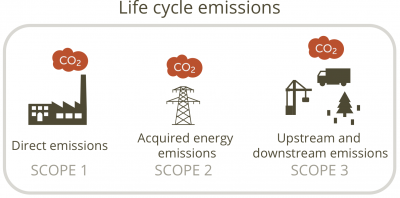OTTAWA — Because its definition of net-zero includes “avoided” emissions and does not require consideration of lifetime emissions when deciding if a project is in the public interest, Canada risks creating loopholes that could dilute the effectiveness of its climate policy, a new paper by the Pembina Institute concludes.
The cornerstone of the federal government’s climate agenda is the commitment to achieve net-zero greenhouse gas emissions by 2050 to help limit warming to 1.5 degrees Celsius to prevent the most catastrophic impacts of climate change. Delivering on this commitment requires defining and operationalizing net-zero in legislation, programs and plans, and decision-making criteria. This was first done in the Strategic Assessment of Climate Change (SACC), a federal government policy document that sets out the parameters for assessing climate change in federal project reviews. However, the equation it uses to determine if net-zero will be reached is flawed.
Not only does it include “avoided” emissions (the difference between the amount of emissions if a project replaces a higher-emitting one), the SACC definition accounts for direct emissions (appropriate when considering mitigation options and conditions of approval for a project) without counting the vast majority of emissions related to a project or facility over its lifetime.
Quotes
“Calculating net-zero emissions should be a simple matter of balancing a budget. On one side we have the amount of carbon pollution we’re still emitting, and on the other the amount of carbon pollution we’re removing through nature-based solutions or technology like carbon capture and storage. But the ledger won’t necessarily be balanced because Canada’s Strategic Assessment of Climate Change equation includes so-called ‘avoided’ emissions while failing to include lifetime emissions. As a result, Canada’s definition of net-zero doesn’t add up. What we count matters.
“The federal government recently announced its plan to get Canada to net-zero by 2050, but if that plan rests on a faulty definition of net-zero, it undermines the potential for meaningful climate action and faith in the government’s climate agenda. What’s more, if the use of avoided emissions and the failure to rigorously assess lifetime emissions is translated to other net-zero policies or pathways, it will significantly and negatively affect their impact.”
— Nichole Dusyk, senior analyst, Pembina Institute
Recommendations
To ensure we maximize our chance of avoiding catastrophic climate change, the Pembina Institute recommends the following components for the net-zero definition and implementation of the Strategic Assessment of Climate Change:
- All high-carbon projects proposed in Canada must be assessed under the Impact Assessment Act.
- All high-carbon projects, including and especially those not required to create a net-zero plan, must commit to continuously reduce emissions throughout their lifetime in line with government interim targets and budgets.
- Canada’s net-zero calculation should not include “avoided” emissions.
- Lifetime emissions must be considered when deciding whether a project is in the public interest.
- Mitigation requirements on projects should result in absolute emissions reductions.
- The need for, and alternatives to, specific projects should always be assessed, even if projects can achieve the goal of net-zero emissions by 2050.
- Where appropriate, projects should strive to reach net-negative emissions.
The net-zero equation in the SACC and net-zero equations recommended by Pembina Institute are documented in “Additional information” below.
[30]
Visit the Pembina Institute’s website to download a copy of Does Canada’s net-zero math add up? The emissions we count and where we count them matters in the Strategic Assessment of Climate Change
Contact
Sarah MacWhirter
Communications director, Pembina Institute
416-389-7465
Background
Report: How to Get Net-Zero Right: Principles, tools and steps for safe, inclusive net-zero pathways
Report: Sustainable finance for a safe climate
Series: The Future of Oil: Drilling down on oil demand
Op-ed: It’s time to bridge the gap between Canada’s energy future and climate targets
Report: A New Canadian Climate Accountability Act
Report: Green Stimulus: Principles and recommendations for a 2020 economic stimulus package
Additional information
The current equation
The federal government Strategic Assessment of Climate Change net-zero equation at the project level calculates greenhouse gas emissions as follows:
Equation 1. Net GHG emissions at the project level equals direct GHG emissions plus acquired energy GHG emissions (e.g. emissions from purchased electricity, steam, heat or cooling), minus captured and stored CO2, offset credits, and avoided domestic GHG emissions (e.g. if a project replaces a higher-emitting one, the difference between the amount of emissions).
This equation fails to include full life cycle emissions:
The equations Canada needs
Rather than the single, net-zero equation in the SACC, the Pembina Institute recommends two equations. First, we need a net-zero equation calculated annually that omits ‘avoided’ domestic emissions. This would be used to determine mitigation obligations for the proponent and, to be deemed credible, it would need to decline in line with Canada’s climate change targets. This equation would look like this:
Equation 2. Net GHG emissions at the project level equals direct GHG emissions plus the balance of emissions from acquired/exported energy, minus captured and stored CO2, and offset credits.
Second, we need a calculation showing all of the emissions over the lifetime of the project which should be used in determining whether a project is in the public interest:
Equation 3. Lifetime GHG emissions equals lifetime direct emissions, plus lifetime balance of emissions from acquired/exported energy plus direct and indirect construction and decommissioning emissions plus lifetime upstream, and downstream emissions minus lifetime emissions captured and stored, and lifetime emissions offset credits.








